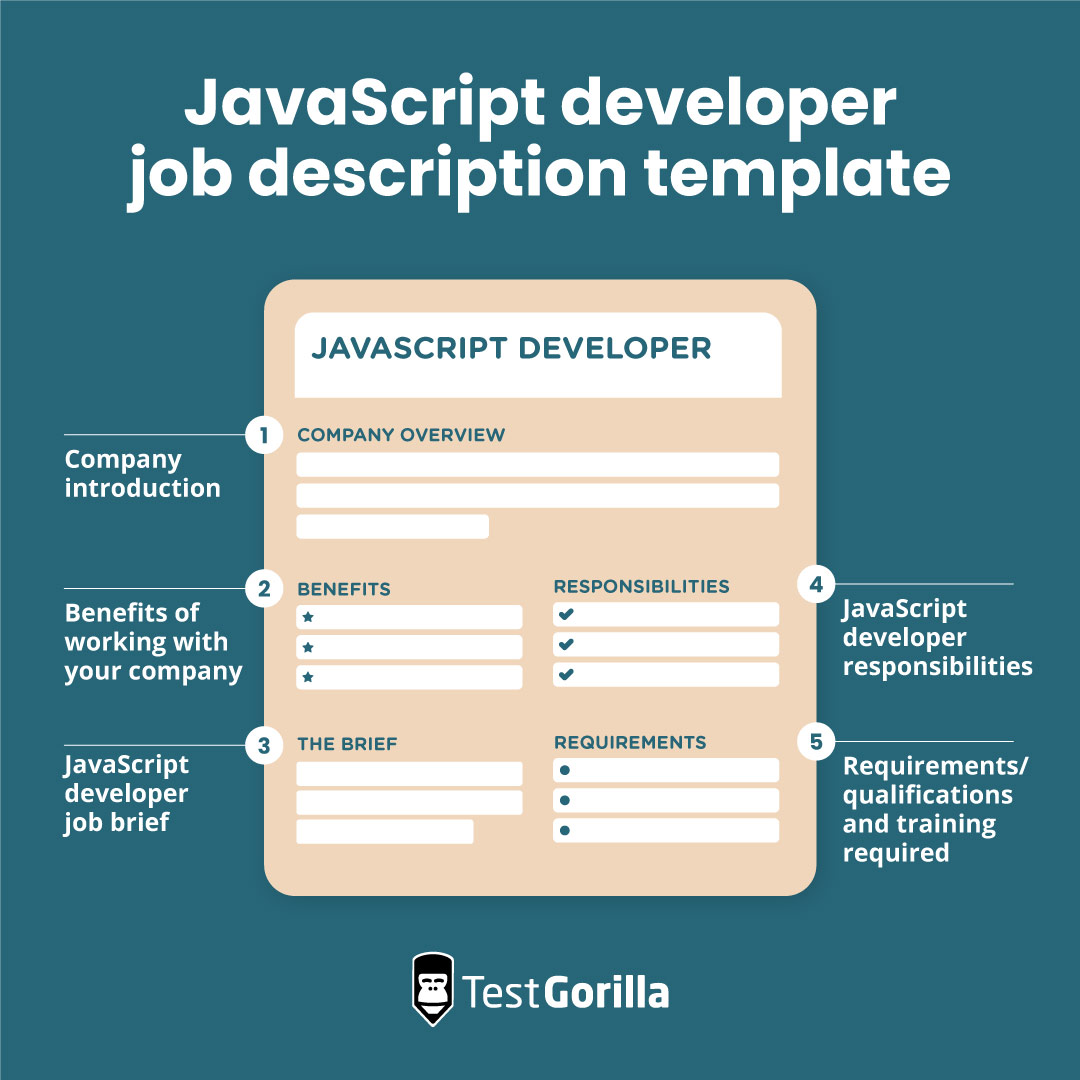Hiring a talented JavaScript developer is crucial when you're building robust web applications and interactive online user experiences.
However, a poorly written job description can inadvertently attract candidates lacking the skills you require, costing you time and affecting project quality.
In the early stages of recruitment, it’s vital to craft the perfect job description that engages skilled candidates who not only have the technical abilities to succeed in the role but also the necessary soft skills to mesh well with your team and company culture.
This guide helps you create an effective, up-to-date job description to secure top JavaScript talent that fits your project needs and company values. We've also included a handy JavaScript developer job description template for your convenience.
Table of contents
- What is a JavaScript developer?
- Key skills to look for in a JavaScript developer
- How to write an effective JavaScript developer job description
- JavaScript developer job description template
- Five things to avoid when writing a job description for a JavaScript developer
- Next steps: Attracting and assessing JavaScript developer candidates
- JavaScript developer job description FAQs
- TestGorilla helps you find the best JavaScript developers
What is a JavaScript developer?
A JavaScript developer specializes in using the JavaScript programming language to build and maintain websites and web applications. This role is essential for creating interactive and user-friendly websites and often collaborates with other developers, designers, and project managers.
JavaScript developers can be involved in both front-end and backend development, depending on the project and the company's needs.
Key skills to look for in a JavaScript developer
Hiring a top-notch JavaScript developer means finding candidates with the following skills, knowledge, and experience:
JavaScript proficiency: A deep grasp of JavaScript fundamentals is a must.
Framework knowledge: Familiarity with frameworks like React, Angular, or Vue.js helps in specific project needs.
HTML/CSS skills: A strong understanding of HTML and CSS complements JavaScript skills, especially for front-end roles.
Version control: Knowing how to use Git aids in code management and team collaboration.
RESTful services: Experience with RESTful services and APIs enables better data integration between client and server.
Problem-solving: Coding is about overcoming challenges. The developer should excel in analytical thinking.
Adaptability: As the tech field is ever-changing, a willingness to learn new languages and frameworks is valuable.
Communication: Being able to articulate complex tech issues in simple terms is essential, especially when interacting with non-technical team members.
Team dynamics: Collaboration skills are crucial, as JavaScript developers often work in cross-functional teams.
Soft skills: Traits like accountability, time management, and attention to detail round out a great candidate.
The best insights on HR and recruitment, delivered to your inbox.
Biweekly updates. No spam. Unsubscribe any time.
How to write an effective JavaScript developer job description
Clearly define the role
Creating a spot-on job description for a JavaScript developer role starts with understanding the nuances of the job you're hiring for. First, clearly define what this developer will do in your organization. Will they focus on front-end development, backend, or full-stack?
Collaborate with your technical team
Next, work with your technical team to list the specific technologies the developer should be proficient in. For JavaScript roles, you might require expertise in frameworks like React, Angular, or Vue.js. Also, mention the developer tools they should be familiar with, like Node.js or Webpack.
Divide skills into must-haves and nice-to-haves
For the skills section, segregate them into "must-haves" and "nice-to-haves." Must-haves could be core JavaScript knowledge, experience with RESTful APIs, and version control using Git. Nice-to-haves might include experience with GraphQL, mobile app development, or familiarity with cloud services like AWS.
Emphasize valued soft skills
Be explicit about the soft skills you value. Communication, teamwork, and problem-solving skills are usually key for any developer role.
Showcase unique aspects of your company
To make sure you're attracting top-tier talent, highlight the unique aspects of the role and your company. Are there professional growth opportunities? Are you using cutting-edge tech stacks? Sharing these perks can pique the interest of top candidates.
Keep your job description up-to-date and compliant
Remember to ensure that your job description is up-to-date, free from discriminatory language, and compliant with legal regulations. Below, we've created a job description template you can use as the basis of your JavaScript developer job post.
JavaScript developer job description template
Company introduction
Introduce your company by touching on its core values, main business focus, and mission. State when the company was founded and any significant milestones.
Explain the critical role JavaScript development plays in achieving the company's objectives to show how important you consider this role to be. Finally, showcase any exciting projects that make your company unique in the marketplace.
Benefits of working with your company
List the rewards of joining your organization, including competitive pay, health benefits, and any retirement plans you offer. Be sure to emphasize additional perks, like ongoing professional development, remote work options, or flexible hours. If your company promotes work-life balance or offers clear career growth paths, mention that too.
JavaScript developer job brief
[Company name]
Job Title: [For example, Senior JavaScript Developer or Junior JavaScript Developer]
Reports to: [For instance, Head of Web Development]
Position type: [Full-time, part-time, on-site, remote, or hybrid]
[Salary and compensation details]
JavaScript developer responsibilities
Writing clean, maintainable JavaScript code for web applications
Working with front-end frameworks like React, Angular, or Vue.js
Partnering with backend developers and designers to build and optimize web experiences
Keeping up with JavaScript language updates and trends
Integrating APIs and data sources into applications
Conducting code reviews and providing constructive feedback
[Add responsibilities specific to your company or project]
JavaScript developer requirements/qualifications and training required
Bachelor's degree in computer science or a similar field
Solid understanding of JavaScript ES6+ syntax and features
Experience with version control systems, such as Git
Familiarity with build tools, like Webpack or Parcel
Strong problem-solving skills
Excellent communication abilities
[Other requirements/qualifications specific to your company]
Five things to avoid when writing a job description for a JavaScript developer
Creating a JavaScript developer job description involves striking a balance – detailed yet concise, specific but not restrictive. Let's go over five common pitfalls to steer clear of.
Using jargon: Avoid heavy use of technical lingo. You don't want to scare off good candidates who might not yet be familiar with every acronym.
Being too vague or too specific: Vague descriptions attract inexperienced or unqualified candidates, while being overly detailed with an abundance of requirements may overwhelm and deter qualified applicants.
Ignoring soft skills: It can be too easy to focus on technical abilities and neglect qualities like teamwork or communication skills.
Non-inclusive language: Ensure your description is free from gendered terms and other discriminatory language. You want to be open to a diverse candidate pool.
Outdated requirements: JavaScript frameworks and tools evolve. Make sure you're not asking for experience in outdated technologies, unless necessary for the role.
Next steps: Attracting and assessing JavaScript developer candidates
After you’ve posted your job description, you'll want to evaluate all the skilled candidates who apply.
To assess JavaScript developer talent, use pre-employment testing from platforms like TestGorilla. You can assess technical know-how alongside cognitive ability and personality for a well-rounded view of each candidate before performing an interview.
Consider using these relevant tests to create a bespoke assessment:
Coding tests that measure essential JavaScript skills
Personality tests to check if the candidate aligns with your company culture
Critical thinking assessments to gauge deductive reasoning abilities
Custom questions that are specific to the role you're hiring for
Explore TestGorilla's extensive library for a variety of tests tailored to JavaScript developer roles.
JavaScript developer job description FAQs
What does a front-end JavaScript developer do?
A front-end JavaScript developer focuses on building the user interface and user experience. They utilize JavaScript and frameworks like React or Angular to create interactive, user-friendly, and visually appealing web pages.
What is the role of a JavaScript backend developer?
A JavaScript backend developer works on server-side operations. Using JavaScript and server-side frameworks like Node.js, they handle data, databases, and application logic.
What is a full-stack JavaScript developer?
A full-stack JavaScript developer works on both the front-end and backend using JavaScript. This includes managing user interfaces, databases, and server-side logic.
TestGorilla helps you find the best JavaScript developers
Now you have the tools to write a great JavaScript developer job description, the true challenge is finding candidates who not only look good on paper but also possess the skills and personality traits you need.
TestGorilla’s multi-measure approach lets you combine job-specific tests with personality assessments to get a comprehensive view of each applicant, enabling you to sift through the talent pool more efficiently.
To jumpstart your JavaScript developer hiring process with accurate, up-to-date tests, sign up for a free TestGorilla account today.
You've scrolled this far
Why not try TestGorilla for free, and see what happens when you put skills first.


















